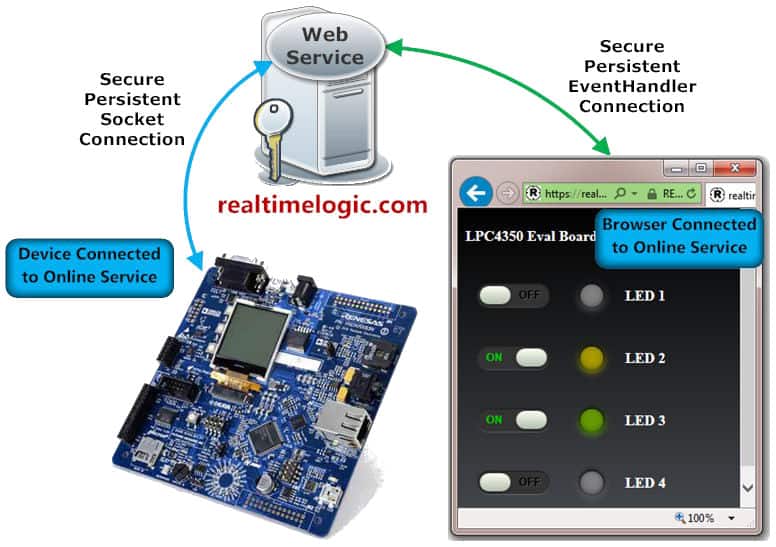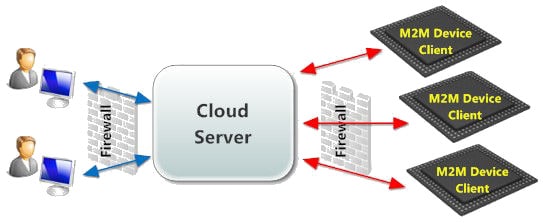|
Complete Suite of Embedded Web Development ToolsStandalone Tools for Embedded Development
IoT Protocols
Quick Look
|
To simplify M2M complexity, Real Time Logic delivers a complete Machine-to-Machine (M2M) framework with a range of solutions with everything from the microcontroller device software to the backend web application server infrastructure. Unlike traditional M2M software, Real Time Logic's complete framework lets you add M2M to any microcontroller or device with minimal software footprint, keeping your communication channels secure, real time, and always connected, thus keeping the device and backend application server communication responsive and secure. |
Web applications on the frontend of the application server translate the captured device event whether it be a motion, temperature change, or something else into usable information such as "there is a security breach," "temperature exceeds limit," or "restock Diet Coke." Although the communication goes machine-to-machine, the frontend web application give humans the information needed to directly interact with the connected devices via the application server. Application servers like this can typically manage thousands of connected devices, serving as an excellent way for humans to manage and coordinate a tremendous amount of mundane information.
Our M2M framework helps you design an M2M Device Client for your microcontroller-based device that can then connect to any type of backend web-service. For the most limited applications involving microcontrollers with limited memory and resources, PikeHTTP, a very fast and small HTTP client library, proves an ideal way to create a communication channel from the device to the backend server. SharkSSL, an SSL/TLS stack, secures all communication. When linked, you have the fundamentals you need to easily design M2M applications that connect to the backend server technology supporting M2M web-services.

M2M LED demo illustrates real-time M2M communication.
With Real Time Logic's backend application servers, your M2M applications can maintain a persistent (i.e., always on, always open) real-time socket communication link between the device and the server. Persistent, real-time communication ensures instant event notification in either direction. Using an HTTP client library in the device is not required when interfacing with our backend server technology, a savings which reduces application size and ensures we can equip even the smallest microcontrollers.
Instead, your application creates a direct persistent, secure communication link over HTTPS via our SharkSSL stack without using PikeHTTP or any other HTTP client library. Our M2M LED demo illustrates how this works. SharkSSL provides a transport-agnostic API designed to be compatible with any type of TCP/IP stack, including event-driven hybrid hardware/software TCP/IP stacks. SharkSSL can be used with or without an RTOS. SharkSSL includes many compile-time options that reduce its footprint to as small as 28 Kbytes.
The benefit: you can M2M-enable small microcontrollers, making it possible to design a device management application for the tiniest microcontroller.
Our application server solutions enables you to write your own device management web applications and web-services for both front- and backend. Designed for easy deployment, our application server solutions make it possible to deploy the frontend web application and backend device web service infrastructure in anything from online cloud servers to small devices such as the Raspberry Pi and the BeagleBoard/BeagleBone boards.
The figure to the right shows a possible deployment scenario, where the combined frontend and backend server software is installed on cloud server infrastructure. This approach gives both humans and devices access to the web applications and M2M web services through firewalls. In this instance, the microcontroller (M2M device client) uses Real Time Logic PikeHTTP and SharkSSL stack to connect to web services on the backend server. |
 |
To ensure you get the best fit for your M2M solution, Real Time Logic provides two low-cost products designed specifically for M2M device management:
Navigate to our downloads section and download our M2M examples and source code.